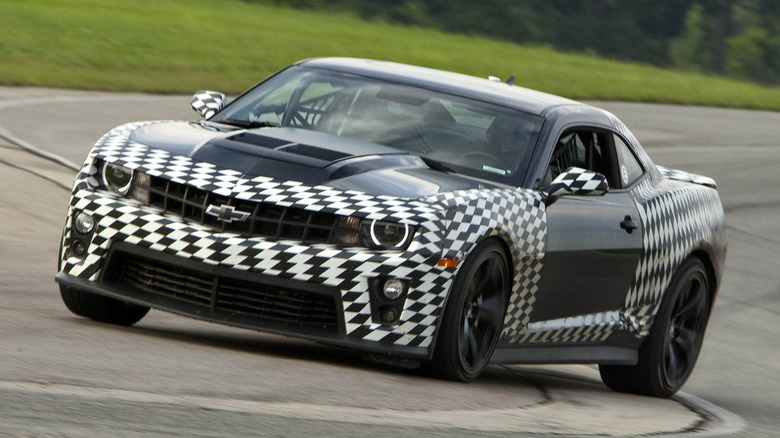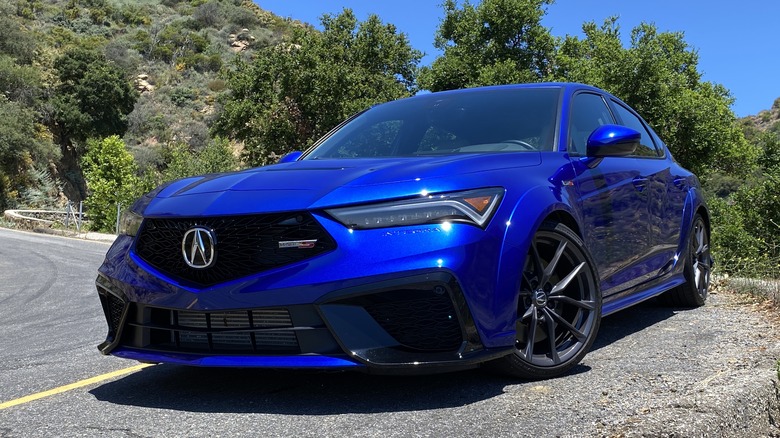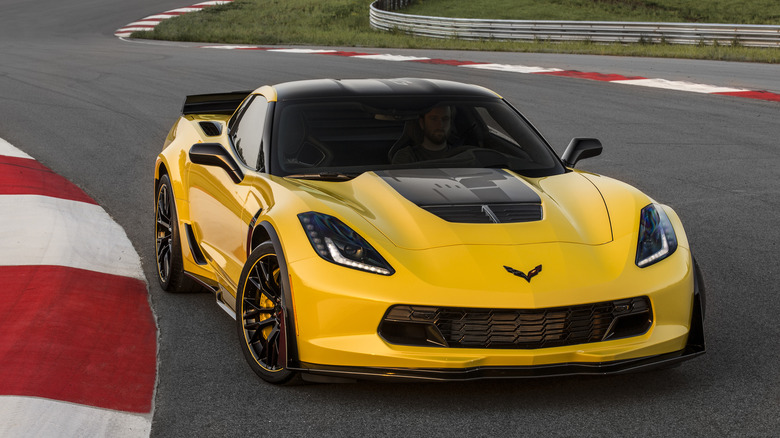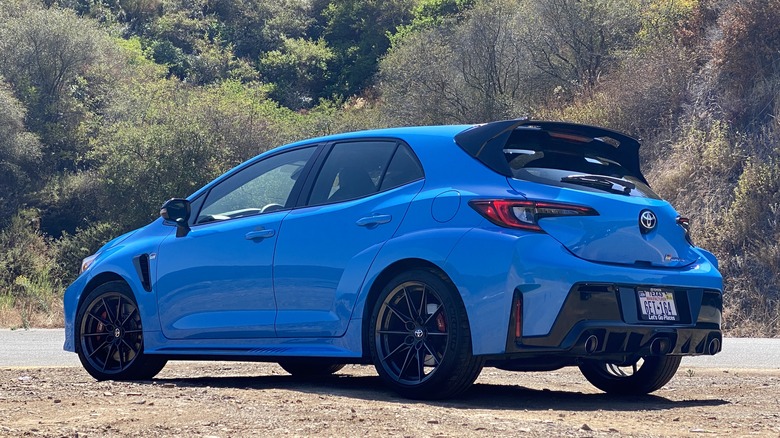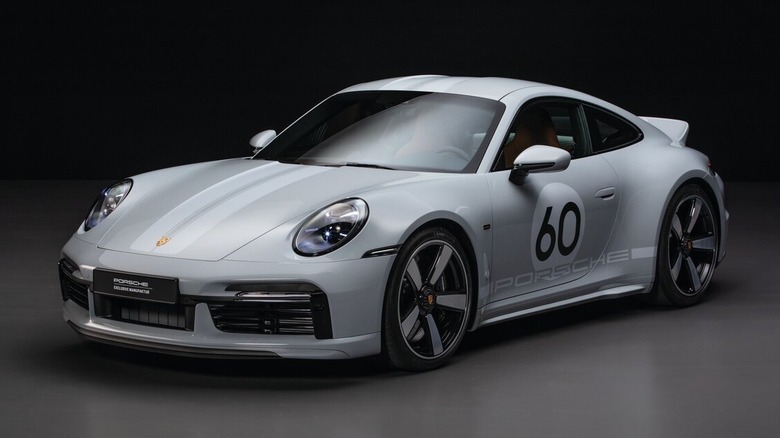The Reason Why You Should Never Buy The First Model Year Of A New Car
When a new car comes to market, there are all sorts of pomp and circumstance surrounding it. For months, the engine specs are leaked, teaser photos are posted around the internet, the car is often spotted in camouflage leaving a manufacturer's private test facility, and then a big reveal comes via a sheet-pull at an auto show or a private event with big lights and a stunning backdrop. All of this is designed to grab your attention and boost interest, and, of course, sell cars. When an auto manufacturer debuts a new vehicle, they want the first year to be successful — a proof of concept so to speak. But, with few exceptions, the first year of a new car may not be the most desirable.
If you want to be the envy of all your pals at the local Cars and Coffee, go ahead and buy the first year of a vehicle, but there are some important things to know about early production models. For starters, the first year of a new vehicle may not be the most mechanically sound. According to Consumer Reports, "reliability-minded" buyers should stay away from new vehicles in their first year. New powertrains are often more likely to present problems. Then, there's the price premium charged for early versions of something new — especially sports cars. Carmakers often add equipment over the life cycle of a vehicle too, meaning the first year could be missing key tech, often released later in a vehicle's life cycle.
The cost of entry is high on new high-performance models
As we've seen quite a bit these last few years, high-performance vehicles can be hot commodities, especially if the manufacturer is limiting production. Dealerships often get limited allocations of these high-performance vehicles, and they price them to reflect their desirability. Unfortunately, that sometimes translates to ADM, also known as additional dealer markup or adjusted dealer markup. ADM is an increase in price added by the dealership, not included in the manufacturer's suggested retail price (MSRP). ADM is also sometimes referred to as market adjustment or market premium, but it's the same thing — an added cost on top of the MSRP because the market demand for a vehicle is high, or the supply numbers are low.
We saw a lot of this during the height of the COVID-19 pandemic and the ensuing supply chain issues, as sports cars, rare vehicles, and already-expensive vehicles had markups of $20,000 or more. An Acura Integra Type S, early in the vehicle's production, was listed with an ADM of $15,000,but many dealers are listing that exact car closer to MSRP now that it's been on sale for a while. Sometimes, waiting for more production models of a vehicle to be made can mean lower prices. As more models hit dealership showrooms, consumers are less likely to pay extra fees and the ADM comes down or is eliminated entirely.
New powertrains could have unexpected issues
Manufacturers exhaustively test new engines and powertrains before they are released to the public. If you've ever seen photos of a camouflaged vehicle, you'll understand that these new cars and trucks are on the road, racking up miles in tough climates before they ever go on sale. But the amount of miles a research and development team can drive pales in comparison to thousands of vehicles on the road, in the hands of the public, putting down millions of miles on their own.
The second-generation Subaru BRZ and Toyota GR86, for example, went to market with some big problems. Many owners reported problems with excessive sealant in the engine, potentially blocking the oil pickup tube and causing engine failure. Chevy's C7 Corvette Z06 is another example of a car that had issues early in its run. The C7 Z06 had cooling issues during its early years, especially for owners that took their high-performance Vette' to the track — issues that Chevy addressed with later models.
The most-exclusive versions of a vehicle may be available down the line
Most cars in the United States are on similar redesign cycles. In general, every five to 10 years, cars are "fully redesigned" which usually means a complete change to the exterior and interior of the car, some big updates to the powertrains, and potentially even some changes to underpinnings. But halfway through that cycle, there's the mid-cycle refresh also known as a facelift. The manufacturer will update features like the bumpers, headlights and taillights, sometimes the powertrains, and often, the tech. Upgraded features, added safety equipment, and the sleekest look for any given typically comes after the refresh. The GR Corolla, for example, took a few years to add launch control and an automatic transmission to the lineup (I'd still go with the manual to be clear) and if you bought one early, you'd miss out on those choices.
Vehicles like the Dodge Challenger are a great example of special-edition trims being added over time. The Demon 170 for example, is one of the most insane versions of a street car ever built, and it didn't come out until very late in the Challenger's run. Then, there's the C8 Chevy Corvette. Sure, the first model year of the new mid-engine Vette' is good to drive, but since its release, Chevy has come out with the E-Ray, the Z06, and the new 1,064-horsepower ZR1. All of those are highly-desirable versions of the Corvette that you might've missed had you bought a first-year model instead.
Some exceptions to the rule
Remember those exceptions that were mentioned earlier? Let's talk about those. Vehicles with one-year-only special-edition models might just be worth getting early. They still fall victim to the same potential downsides as other first-year cars, but the payoff could be worth it. For instance, referring back to a car like the GR Corolla, which was only available in the Morizo Edition during its first year of production, is a model you may want to own. It has special equipment and rare production numbers, so it could be worth the risk.
Also, if you think a vehicle might not last in its current form, it might be worth purchasing it regardless of it being the first year of production. Porsche is notorious for selling ultra-rare versions of its cars like the 911 Sport Classic that are limited in production, and get snapped up by brand loyalists in a hurry, so you better get it while you can. Or, there's the BMW 1 M which was only available for a single year of sales. Seems like you'd probably want to grab that one pretty quickly.
